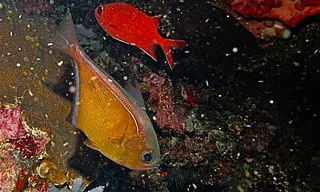
Sweepers are small, tropical marine perciform fish of the family Pempheridae. Found in the western Atlantic Ocean and Indo-Pacific region, the family contains about 26 species in two genera. One species is the target of subsistence fisheries in Japan, where the fish is much enjoyed for its taste. Sweepers are occasionally kept in marine aquaria.

Ridgeheads, also known as bigscales, are a family of small, deep-sea stephanoberyciform fish. The family contains approximately 37 species in five genera; their distribution is worldwide, but ridgeheads are absent from the Arctic Ocean and Mediterranean Sea. Although the family is one of the most widespread and plentiful of deep-sea families, none of its members are of interest to commercial fishery.

The parore also known as luderick, black bream or blackfish is a species of marine ray-finned fish, a sea chub from the family Kyphosidae which is found in the southwestern Pacific Ocean off Australia and New Zealand. Parore or paraore is the common name in New Zealand but in Australia luderick is preferred.

Mycteroperca microlepis, the gag, gag grouper, velvet rockfish or charcoal belly, is a species of marine ray-finned fish, a grouper from the subfamily Epinephelinae which is part of the family Serranidae, which also includes the anthias and sea basses. It comes from warmer parts of the West Atlantic, including the Caribbean and Gulf of Mexico. It is a drab, mottled-gray fish lacking the distinguishing features of most other groupers. Its pattern of markings resemble the box-shaped spots of the black grouper. It lacks the streamer-points on the tail fin that scamp and yellowmouth grouper have, and lacks yellow coloration around the mouth.

The latticed butterflyfish, also known as Raffles’ coralfish, is a species of marine ray-finned fish, a butterflyfish belonging to the family Chaetodontidae. It is found in the Indo-Pacific region.

Cephalopholis fulva, the coney or the butterfish, is a species of marine ray-finned fish, a grouper from the subfamily Epinephelinae which is in the family Serranidae which also includes the anthias and sea basses. It is found in the western Atlantic. It is associated with reefs and is a quarry species for commercial and recreational fisheries. It can be found in the aquarium trade.

Plectorhinchus albovittatus, the two-striped sweetlips or giant sweetlips, is a species of marine ray-finned fish, a sweetlips belonging to the subfamily Plectorhinchinae, part of the grunt family Haemulidae. It is native to the Indian Ocean and the western Pacific Ocean.

Acanthurus nigricauda, the epaulette surgeonfish, black-barred surgeonfish, eye-line surgeonfish, shoulderbar surgeonfish, white-tail surgeonfish or blackstreak surgeonfish, is a tropical fish in the family Acanthuridae. It is native to the Indo-Pacific region.

The sooty grunter, also known by the name black bream, blubberlips, Northern grunter or purple grunter, is a species of freshwater ray-finned fish, a grunter from the family Terapontidae. It inhabits coastal and inland freshwater creeks and rivers of northern Australia.

The redmouth grouper, also known as the red-flushed rock cod is a species of ray-finned fish, a grouper from the subfamily Epinephelinae which is part of the family Serranidae, which also includes the anthias and sea basses. It has a wide distribution in the Indian and Pacific Oceans. It is considered a game fish.

Diploprion bifasciatum, the barred soapfish, also known as the doublebanded soapfish, two banded grouper, two-banded sea perch, two-banded soapfish, yellow emperor or yellow striped grouper, is a species of marine ray-finned fish, related to the groupers and included in the subfamily Epinephelinae which is part of the family Serranidae, which also includes the anthias and sea basses. It is found in the Indo-Pacific region.

Terapon theraps, the largescaled terapon, banded grunter, banded trumpeter, flagtail grunter, flagtail trumpeter, large-scaled grunter-perch, Northern grunter and spiky trumpeter, is a species of marine ray-finned fish, a grunter from the family Terapontidae. This species has a wide distribution in the Indo-Pacific region.

Heniochus singularius, the singular bannerfish, is a species of marine ray-finned fish, a butterflyfish from the family Chaetodontidae. It is found in the Indo-Pacific region.

Macolor macularis, the midnight snapper, midnight seaperch or black and white snapper, is a species of marine ray-finned fish, a snapper belonging to the family Lutjanidae. It is native to the Indian and western Pacific Oceans.

Pempheris vanicolensis, the Vanikoro sweeper or greenback bullseye is a species of Indo-Pacific fish from the family Pempheridae, the sweepers.

Pempheris mangula, the black-edged sweeper, Moluccan sweeper or black-margin bullseye is a species of Indo-Pacific sweeper from the family Pempheridae. The history of the identification of the Indo-Pacific sweepers is complex and this species has been identified as the "Pempheris vanicolensis" which has colonised the Mediterranean Sea from the Red Sea via the Suez Canal by Lessepsian migration but this identification is not universally accepted.
Pempheris poeyi, the curved sweeper and shortfin sweeper, is a species of marine ray-finned fish, a sweeper in the family Pempheridae from the western Atlantic Ocean.

Pempheris adusta, the dusky sweeper, is a species of marine ray-finned fish in the family Pempheridae, the sweepers. It is common species on coral reefs in the Indo-Pacific region.

Pempheris affinis, the black-tipped bullseye, is a species of marine ray-finned fish in the family Pempheridae, the sweepers. It is from the southwestern Pacific Ocean.

The sea trumpeter is a species of marine ray-finned fish, a grunter from the family Terapontidae. It is endemic to the southeastern Indian Ocean off the southwestern coats of Australia.



















